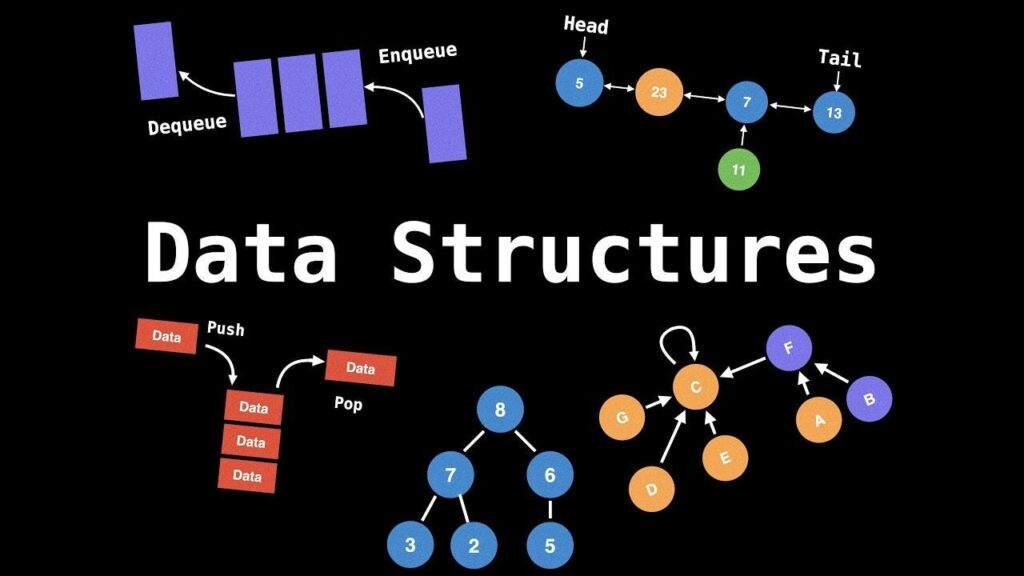In the world of computer programming, understanding data structures and algorithms is crucial for becoming an efficient developer. While it may seem daunting at first, mastering these topics transforms how you solve coding problems, optimize code, and ultimately succeed in a tech career. Whether you’re interested in front-end development, back-end development, or full-stack development, data structures and algorithms play a fundamental role in shaping you into a versatile and proficient developer.

What Are Data Structures and Algorithms?
Before diving into why these skills are essential, let’s start with a quick overview:
- Data Structures: These are specific ways of organizing, managing, and storing data so it can be used effectively. Common examples include arrays, linked lists, stacks, queues, trees, and graphs. Each data structure has unique properties that make it suitable for different types of applications.
- Algorithms: Algorithms are step-by-step procedures or formulas for solving problems. They range from simple sorting methods to complex graph traversal techniques. Algorithms determine the logic and flow of a program, impacting its speed, efficiency, and scalability.
Learning data structures and algorithms isn’t just about memorizing definitions or code snippets; it’s about understanding how to use them to solve real-world coding problems.
Why Data Structures and Algorithms Matter
1. Enhanced Problem-Solving Skills
Developing a solid grasp of data structures and algorithms enhances your ability to tackle complex problems. Each problem has an optimal solution, and often, the choice of data structure and algorithm determines the efficiency of that solution. For example, if you need to store data temporarily, a stack or queue might be ideal. If you’re working with large datasets, a binary tree or hash table can improve performance significantly.
Coding challenges on platforms like LeetCode and HackerRank are designed to strengthen problem-solving skills by exposing you to various data structures and algorithmic techniques. Regular practice with these challenges builds a deeper understanding of how different solutions work, helping you become a more resourceful developer.
2. Optimized Code Performance
Efficient code is at the heart of any successful application, and optimizing code often comes down to choosing the right data structures and algorithms. An application’s performance can make or break the user experience, especially in fields like software engineering and full-stack development, where high-performance code is essential.
By learning how to analyze the time and space complexity of an algorithm (often referred to as Big O notation), developers can evaluate the efficiency of their code and make informed choices. Optimized code not only improves performance but also reduces resource usage, which is vital in modern applications.
3. Essential for Technical Interviews
Data structures and algorithms are cornerstones of technical interviews. Companies often use these topics to gauge a candidate’s coding ability, problem-solving skills, and logical thinking. Mastering data structures and algorithms significantly increases your chances of landing a job at top tech companies, as interview questions are frequently based on these concepts.
Preparing for technical interviews involves regular practice through coding exercises and programming projects that test your understanding of various data structures and algorithmic techniques. Coding platforms offer mock interview questions that mimic real-world scenarios, giving you the confidence to tackle interview questions effectively.
Key Data Structures Every Developer Should Know
Mastering data structures is about knowing which structure to use for different programming tasks. Here are some fundamental data structures every developer should understand:
- Arrays and Lists: Simple yet powerful, arrays and lists are used to store a collection of items in a specific order. They are essential for handling a variety of programming problems.
- Stacks and Queues: These data structures follow specific order rules (LIFO for stacks and FIFO for queues) and are used in scenarios like function calls, undo mechanisms, and task scheduling.
- Hash Tables: Extremely useful for fast data retrieval, hash tables map keys to values and are widely used in databases and caches.
- Trees and Graphs: Trees and graphs are used to model hierarchical and interconnected data. They are essential in network design, social media platforms, and search engines.
Learning each data structure’s properties, advantages, and limitations prepares you to solve a broad range of coding problems efficiently.
Why Algorithms Are Essential for Developers
Algorithms provide a blueprint for solving problems, allowing developers to devise efficient solutions to complex tasks. Some key algorithm categories every developer should explore include:
- Sorting Algorithms: Sorting data efficiently is fundamental in coding. Popular algorithms include bubble sort, quicksort, and mergesort, each with varying efficiencies depending on the dataset.
- Search Algorithms: Searching for data is a common task, and algorithms like binary search and linear search help locate data quickly within different structures.
- Graph Algorithms: Graph algorithms, such as depth-first search (DFS) and breadth-first search (BFS), are crucial for understanding relationships and paths between data points.
- Dynamic Programming: Dynamic programming optimizes complex problems by breaking them down into subproblems and storing intermediate results, making it essential for solving high-complexity tasks.
An algorithms course can provide in-depth understanding and exposure to these key types, helping you develop well-rounded problem-solving skills applicable to various programming roles.
Learning Resources for Data Structures and Algorithms
There are plenty of resources available for mastering data structures and algorithms. For beginners, online coding tutorials and structured courses offer step-by-step guidance. Here are some top resources to consider:
- Coursera and edX: Platforms that offer structured data structures and algorithms courses from top universities.
- Coding Bootcamps: Many coding bootcamps include dedicated sections on data structures and algorithms, offering intensive training.
- Coding workshops: Local or online workshops often include hands-on coding exercises, allowing you to practice these concepts in a real-time environment.
- Books: “Cracking the Coding Interview” by Gayle Laakmann McDowell and “Introduction to Algorithms” by Thomas H. Cormen are excellent resources for developing a deeper understanding.
- Practice Sites: Platforms like LeetCode, HackerRank, and CodeSignal provide practice questions that reinforce your understanding of data structures and algorithms.
Data Structures and Algorithms in Real-World Applications
Understanding data structures and algorithms isn’t just for interviews; it has real-world applications in every corner of software development. For instance:
- In Front-End Development: Algorithms are used to optimize loading times, handle DOM manipulation, and improve data retrieval speeds. Data structures like trees are commonly used in managing nested data for front-end applications.
- In Back-End Development: Complex databases rely heavily on data structures and algorithms to ensure fast data retrieval, efficient storage, and seamless user experiences.
- In Full-Stack Development: Full-stack developers benefit from understanding both front-end and back-end structures, as they must manage how data flows from server to user interface.
Mastering these concepts ensures you can build scalable, efficient applications that handle data effectively across all areas of development.

Make Data Structures and Algorithms Your Foundation
Data structures and algorithms are the cornerstone of coding education. They enhance your problem-solving abilities, prepare you for technical interviews, and help you create optimized, efficient applications. Mastering these topics provides a strong foundation for any development role, from front-end to full-stack development.
Start with beginner-friendly resources and work your way up to more advanced concepts, practicing with real-world coding challenges and exercises along the way. By dedicating time to understand and practice data structures and algorithms, you’ll unlock new opportunities in your programming journey and set yourself apart as a skilled developer.




